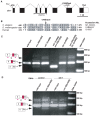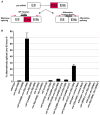Mutations in the Caenorhabditis elegans U2AF large subunit UAF-1 alter the choice of a 3' splice site in vivo
- PMID: 19893607
- PMCID: PMC2762039
- DOI: 10.1371/journal.pgen.1000708
Mutations in the Caenorhabditis elegans U2AF large subunit UAF-1 alter the choice of a 3' splice site in vivo
Abstract
The removal of introns from eukaryotic RNA transcripts requires the activities of five multi-component ribonucleoprotein complexes and numerous associated proteins. The lack of mutations affecting splicing factors essential for animal survival has limited the study of the in vivo regulation of splicing. From a screen for suppressors of the Caenorhabditis elegans unc-93(e1500) rubberband Unc phenotype, we identified mutations in genes that encode the C. elegans orthologs of two splicing factors, the U2AF large subunit (UAF-1) and SF1/BBP (SFA-1). The uaf-1(n4588) mutation resulted in temperature-sensitive lethality and caused the unc-93 RNA transcript to be spliced using a cryptic 3' splice site generated by the unc-93(e1500) missense mutation. The sfa-1(n4562) mutation did not cause the utilization of this cryptic 3' splice site. We isolated four uaf-1(n4588) intragenic suppressors that restored the viability of uaf-1 mutants at 25 degrees C. These suppressors differentially affected the recognition of the cryptic 3' splice site and implicated a small region of UAF-1 between the U2AF small subunit-interaction domain and the first RNA recognition motif in affecting the choice of 3' splice site. We constructed a reporter for unc-93 splicing and using site-directed mutagenesis found that the position of the cryptic splice site affects its recognition. We also identified nucleotides of the endogenous 3' splice site important for recognition by wild-type UAF-1. Our genetic and molecular analyses suggested that the phenotypic suppression of the unc-93(e1500) Unc phenotype by uaf-1(n4588) and sfa-1(n4562) was likely caused by altered splicing of an unknown gene. Our observations provide in vivo evidence that UAF-1 can act in regulating 3' splice-site choice and establish a system that can be used to investigate the in vivo regulation of RNA splicing in C. elegans.
Conflict of interest statement
The authors have declared that no competing interests exist.
Figures






Similar articles
-
RBM-5 modulates U2AF large subunit-dependent alternative splicing in C. elegans.RNA Biol. 2018;15(10):1295-1308. doi: 10.1080/15476286.2018.1526540. Epub 2018 Oct 13. RNA Biol. 2018. PMID: 30295127 Free PMC article.
-
The Caenorhabditis elegans gene mfap-1 encodes a nuclear protein that affects alternative splicing.PLoS Genet. 2012;8(7):e1002827. doi: 10.1371/journal.pgen.1002827. Epub 2012 Jul 19. PLoS Genet. 2012. PMID: 22829783 Free PMC article.
-
The survival motor neuron gene smn-1 interacts with the U2AF large subunit gene uaf-1 to regulate Caenorhabditis elegans lifespan and motor functions.RNA Biol. 2014;11(9):1148-60. doi: 10.4161/rna.36100. RNA Biol. 2014. PMID: 25483032 Free PMC article.
-
U2AF homology motifs: protein recognition in the RRM world.Genes Dev. 2004 Jul 1;18(13):1513-26. doi: 10.1101/gad.1206204. Genes Dev. 2004. PMID: 15231733 Free PMC article. Review.
-
Alternative Splicing in CKD.J Am Soc Nephrol. 2016 Jun;27(6):1596-603. doi: 10.1681/ASN.2015080908. Epub 2016 Jan 13. J Am Soc Nephrol. 2016. PMID: 26763787 Free PMC article. Review.
Cited by
-
RBM-5 modulates U2AF large subunit-dependent alternative splicing in C. elegans.RNA Biol. 2018;15(10):1295-1308. doi: 10.1080/15476286.2018.1526540. Epub 2018 Oct 13. RNA Biol. 2018. PMID: 30295127 Free PMC article.
-
Strict 3' splice site sequence requirements for U2 snRNP recruitment after U2AF binding underlie a genetic defect leading to autoimmune disease.RNA. 2011 Mar;17(3):401-11. doi: 10.1261/rna.2444811. Epub 2011 Jan 13. RNA. 2011. PMID: 21233219 Free PMC article.
-
KH domain containing RNA-binding proteins coordinate with microRNAs to regulate Caenorhabditis elegans development.G3 (Bethesda). 2021 Feb 9;11(2):jkab013. doi: 10.1093/g3journal/jkab013. G3 (Bethesda). 2021. PMID: 33585875 Free PMC article.
-
The Caenorhabditis elegans gene mfap-1 encodes a nuclear protein that affects alternative splicing.PLoS Genet. 2012;8(7):e1002827. doi: 10.1371/journal.pgen.1002827. Epub 2012 Jul 19. PLoS Genet. 2012. PMID: 22829783 Free PMC article.
-
CCAR-1 works together with the U2AF large subunit UAF-1 to regulate alternative splicing.RNA Biol. 2024 Jan;21(1):1-11. doi: 10.1080/15476286.2023.2289707. Epub 2023 Dec 21. RNA Biol. 2024. PMID: 38126797 Free PMC article.
References
-
- Maniatis T, Tasic B. Alternative pre-mRNA splicing and proteome expansion in metazoans. Nature. 2002;418:236–243. - PubMed
-
- Reed R. Mechanisms of fidelity in pre-mRNA splicing. Curr Opin Cell Biol. 2000;12:340–345. - PubMed
-
- Graveley BR. Alternative splicing: increasing diversity in the proteomic world. Trends Genet. 2001;17:100–107. - PubMed
-
- Smith CW, Valcarcel J. Alternative pre-mRNA splicing: the logic of combinatorial control. Trends Biochem Sci. 2000;25:381–388. - PubMed
Publication types
MeSH terms
Substances
Grants and funding
LinkOut - more resources
Full Text Sources
Molecular Biology Databases

